Called Martti and based on research from VTT’s AC Marilyn, the vehicle is equipped with cameras, antennas, sensors and three laser sensors that detect the environment ahead. By mid-January, it will also be equipped with communication modules which are designed with the intention of communicating with digital transport infrastructure.
To enhance the car’s capacity to function on slippery road surfaces, VTT will begin changing the wavelengths of the optical components, increasing the resolution of the radar, and building more intelligence into the sensors’ software.
Matti Kutila from VTT’s RobotCar Crew, said: “When in spring 2017 we, the researchers, taught the automated car Marilyn to drive, this autumn it has been teaching us on how to make Martti such that it can get along with its spouse, and follow GPS and positioning information on its route. Martti has been designed for demanding weather conditions and Marilyn shines as the queen of urban areas.
“We already have at our disposal an intelligent roadside unit, capable of feeding local information for the insatiable needs of Martti and Marilyn. This cart dubbed Marsu contains measuring devices for friction data and a communications module serving as a base station. Furthermore, next Spring one of our vehicles can also be spotted in forest environments, when Marilyn and Martti get a new friend capable of tackling all terrains,” Kutila added.
VTT launches AV for snow and ice conditions, Finland
VTT Technical Research Centre (VTT) of Finland has launched what it claims to be the first autonomous car (AC) to have successfully driven on a real snow-covered road. It also reached speeds of up to 40 km/h during a trial on the Aurora E8 intelligent road in Muonio.
December 18, 2017
Read time: 2 mins








